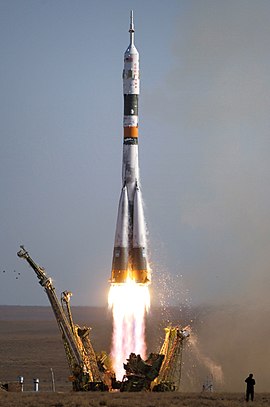Soyuz-Fregat

A Soyuz-FG rocket carrying a Soyuz TMA spacecraft launches from Baikonur Cosmodrome, Kazakhstan on 18 September 2006.
|
|
| Function | Carrier rocket |
|---|---|
| Manufacturer |
OKB-1 Progress State Research and Production Rocket Space Center |
| Country of origin | USSR Russia |
| Size | |
| Stages | 3 |
| Associated rockets | |
| Family | R-7 |
| Launch history | |
| Status | Active |
| Launch sites | |
| First flight | 28 November 1966 |
| Notable payloads |
Soyuz Progress |
Soyuz (Russian: Союз, meaning "union", GRAU index 11A511) is a family of expendable launch systems developed by OKB-1, and manufactured by Progress State Research and Production Rocket Space Center in Samara, Russia. The Soyuz launch vehicle is the most frequently used launch vehicle in the world.
After the U.S. Space Shuttle program ended in 2011, Soyuz rockets became the only launch vehicle able to transport astronauts to the International Space Station.
The Soyuz vehicles are used as the launcher for the manned Soyuz spacecraft as part of the Soyuz program, as well as to launch unmanned Progress supply spacecraft to the International Space Station and for commercial launches marketed and operated by Starsem and Arianespace. All Soyuz rockets use RP-1 and liquid oxygen (LOX) propellant, with the exception of the Soyuz-U2, which used Syntin, a variant of RP-1, with LOX. In the United States, it has the Library of Congress designation A-2. The Soyuz family is a subset of the R-7 family.
The Soyuz launcher was introduced in 1966, deriving from the Vostok launcher, which in turn was based on the 8K74 or R-7a intercontinental ballistic missile. It was initially a three-stage rocket with a Block I upper stage. Later a Molniya variant was produced by adding a fourth stage, allowing it to reach the highly elliptical molniya orbit. A later variant was the Soyuz-U.
...
Wikipedia
